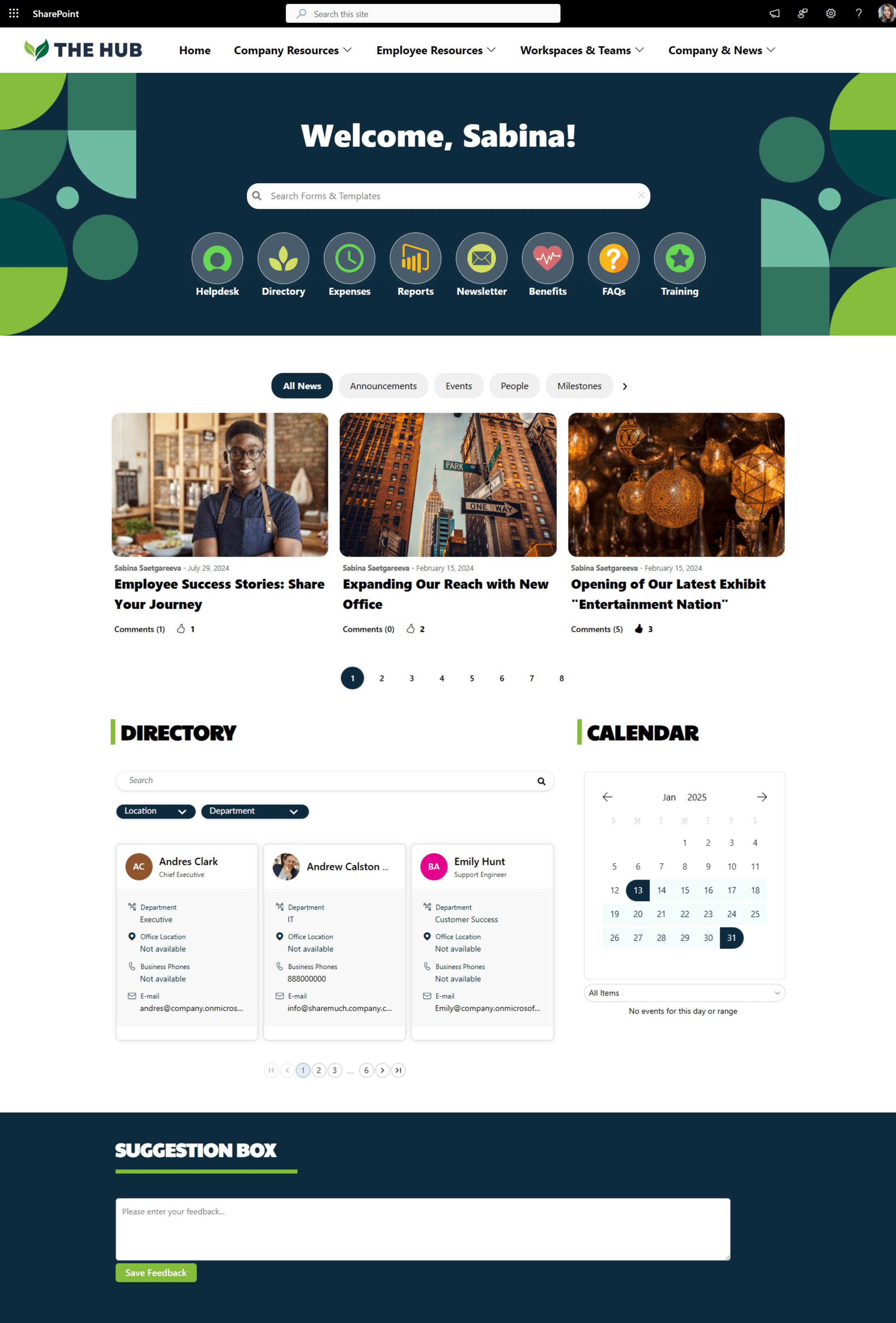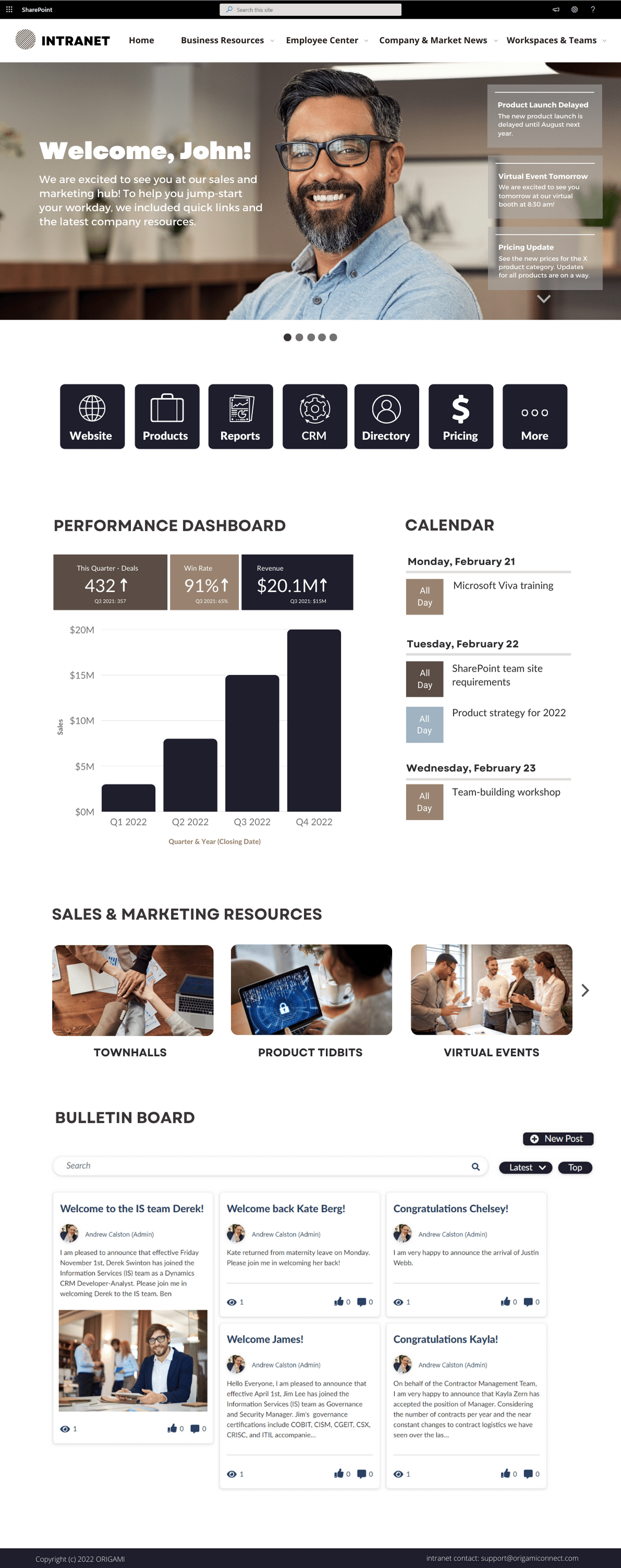Building intranets for 15 years has taught me this one thing - people hate spending money on unnecessary consulting fees.
Ask anybody, how do they feel when they already spend premium on SharePoint and get a blank page to start with. Where is the value in that??
With Intranet Themes, Intranet Templates, and Pre-Built Intranets there is a solution to get your ROI on SharePoint, but which one do you need?
The right solution will depend on your company size because how collaboration scales.
Intranet Theme (for companies of about ~30 users)
Think of an intranet theme like you would a PowerPoint theme, but for your intranet. You take a pre-existing document and apply a theme to make it prettier. You still have to build out your intranet before you can make it pretty, just like you’d have to write a PowerPoint document before applying a visually appealing theme.
What most people don’t realize about a theme:
You still have to do all the work building out your intranet OR
… have an existing pre-built intranet.
Some themes you buy now may not be compatible with future upgrades done to SharePoint.
Themes provide a visual face-lift including with:
Colors
Backgrounds
Fonts Options
You are constrained with a very limited functionality of what you can and can’t change in the theme.
Some themes will have a “control panel“ with switches and toggles and that’s all you have to work with
Custom apps you may have built in your intranet may not get “theme’ed”.
Themes are usually inexpensive.
Support services are usually very basic - so if anything breaks beyond the theme, it’s your responsibility to fix it.
Target audience: Organizations between ~30 users.
Recommendation:
SharePoint Online look and feel is now so much better that many of the themes out there are just not necessary in my opinion.
Intranet Template (for companies between 50 ~ 130 users)
An intranet template is a generic template built to fill the needs of hundreds.
For example, you may have template which gives you most common department sites but you don’t have those departments. Or it can give you Employee Gallery site, but you have no-one to moderate it.
In other words, templates are generic and you’re likely in charge of all the maintenance and adoption.
You’ll have to work around the constraints of the template, keeping features you may not need and finding ways to customize things you want but are not included. It’s a quick
Key things people don’t realize about Intranet Templates:
Basic installation may be included. Some products offer a manual with the install package you need to run.
Templates that are pay-once use forever may not include maintenance, so if Microsoft changes anything in the platform which breaks your template features - you may need to pay extra for consulting services to fix it.
You can use template as a starting points for specific part of your intranet:
Example: Helpdesk Template - will provide helpdesk workflows and functionality to an existing intranet whether you have one or not.
Templates may come with a theme:
Colors, backgrounds, and fonts, but those are often limited to elements in the template and not everything else in your intranet.
You’re likely to be able to re-arrange what’s inside the template (apps) but not change the functionality of the apps.
Templates are more expensive than themes on average 3-4 times.
Target audience: Organizations between 50 ~ 130 users
Recommendation:
If you’re small company with a limited budget, template might be a way to get started quickly. You will still be responsible for making all the changes to meet your company needs. Companies beyond 130 employee threshold or rapidly growing organizations should consider using a pre-built intranet. In this threshold, templates are too generic and users end up confused with all the generic areas and information scattered everywhere.
Pre-Built Intranet (if you have 130+ employees)
Pre-built intranet comes with pre-built modules but also services to guide you through the complexities typically seen in organizations of over 130+ users.
In this size threshold, organizations are challenged with:
Ensuring information on the intranet is easy to find.
Facilitate employee engagement.
Simplifying document and information management.
Companies with 130 employees have a completely different dynamic than smaller organizations. Tons of content is being produced daily and you need a pre-built intranet with modules that answer your needs and not add to the clutter.
Good pre-built intranet product company understands this complexity and will include design services to help you set things right. What should raise a red flag is when you hear a promise of launching an intranet in few days. This underestimates the dynamics of how to manage an on-board 130+ users to a new platform to make sure it’s adopted.
What most don’t realize about a Pre-Built intranet:
Pre-built intranet initial cost is more expensive than a template but you are saving on the consulting services needed later to mitigate adoption and user satisfaction concerns.
Pre-built intranet is best to start with rather than applied later in the process when users already started using the site and aren’t happy with it.
You can still apply pre-built modules to existing intranet but you’ll miss out on important design activities which will help you establish a strong intranet.
Apps, workflows, various services, and branding are all typically included.
Some, but not all, pre-built intranet products offer free training, and email support. Some products even offer support beyond what’s in their product.
Target audience: Organizations > 130 users
Recommendation:
If you have 130 employees or more, pick a pre-built intranet with set up services. Knowledgeable intranet product company will offer their set up and design services inclusive because they can recognize that stripping those away will deliver no value.
What else?
One option that hasn’t been mentioned yet is custom intranet. Still a popular choice but beginning to gain a reputation of having much less ROI than before due to an increase in pre-built alternatives on the market.
The key is to accurately assess your company capabilities when going custom. Do you really want to re-invent the wheel?
Nobody likes to pay large consulting bills. Sometimes it may seem like a huge saving to build it all on your own but time and time again I see this result in consulting bills piling up later.
The alternative is also purchasing bits and pieces, templates, themes and apps, overtime. Ultimately, resulting in higher costs and patchwork solutions.
Always remember who you’re building an intranet for: your users. Rarely are they aware of budgets. Everyday interactions is what makes an impact.
Users will never know if the solution was inexpensive or not, but they will remember if it was frustrating to use.
Here to help
If you have questions on how to make your intranet more engaging by starting pre-built and leveraging your existing Office 365 and SharePoint investment, I’ll be happy to speak with you personally.
Yaroslav Pentsarskyy is the Director of Product at Origami. He's also 8 time Microsoft MVP, speaker at many local and worldwide tech events, and a published author of several SharePoint related books.












Get inspired with six company intranet examples built on data collected from hundreds of intranet sites. See intranet best practices and design ideas to help you build an intranet employees will love.